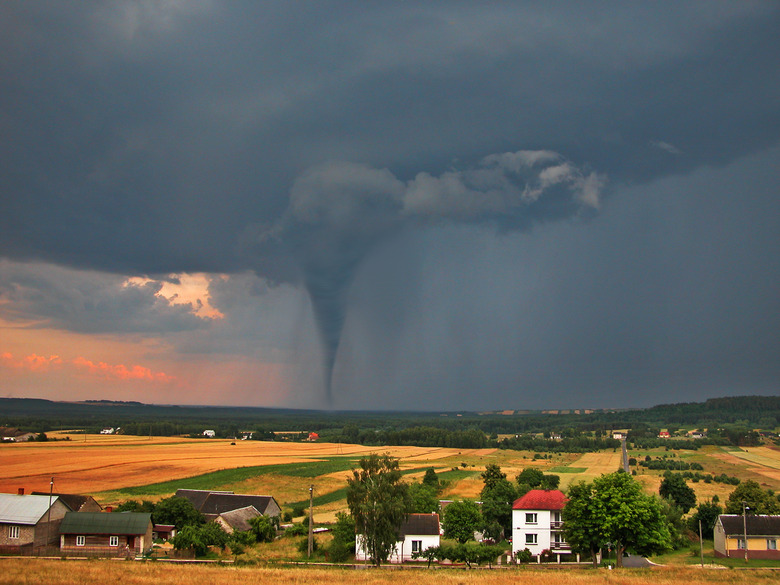Tornadoes' Effects On People
Tornadoes wreak havoc wherever they touch down. Besides causing loss of life, tornadoes move buildings, pluck trees from the Earth and send anything not anchored to the ground flying through the air. Most of the people who live where tornadoes occur regularly have underground shelters to keep them protected as they ride out the storm.
TL;DR (Too Long; Didn't Read)
When you live where tornadoes frequently occur, locate the tornado shelters in your area, or develop an emergency plan for all members of the family. Have an agreed up location to meet after the tornado in the event family members are separated. The National Oceanic and Atmospheric Administration recommends the following tornado safety tips:
**Houses with a basement** – Get into the basement, avoid windows and hide beneath a sturdy table, mattress or even a sleeping bag. Map out where heavy objects are on the floor above, and avoid hiding in the basement beneath such items as waterbeds, refrigerators, washers and dryers or other heavy objects.
**Houses without basements** – Move quickly to the lowest floor of the home and find a small center room, such as a bathroom or closet in which to hide. Avoid windows and cover yourself with thick padding to protect from falling beams, boards or other debris. The inside of a cast-iron tub with sufficient padding may keep you safe.
**Mobile homes** – Don't stay in a mobile home, these are not safe at all during a tornado. Know in advance the emergency shelters in your area and go there or find a sturdy building in which to hide.
**Open outdoors** – Find a sturdy building, ditch or depression to lay in face down with your head covered. Don't hide beneath trees or around vehicles, both of which can become flying objects during a tornado.
Loss of Life
Loss of Life
After heatwaves, hurricanes and floods, tornadoes rank as the fourth most lethal weather pattern in the United States. U.S. death tolls from tornadoes vary considerably from one year to the next. Since 2000, death tolls have ranged from a low of 21 in 2009 to a high of 553 in 2011, with an average of 94 deaths a year for that period. The high death toll in 2011 was due partly to the 2011 tornado super outbreak, in which some 748 tornadoes occurred in the month of April, followed by a devastating tornado strike on Joplin, Missouri, in May.
The unprecedented April 2011 outbreak surpassed even the infamous 1974 tornado season, when a single weather system spawned some 147 tornadoes in just 24 hours. Tornadoes that happen at night tend to be the deadliest because people who are asleep do not receive the tornado warning in time.
Location, Location, Location
Location, Location, Location
The effects a tornado has on human life depends on its strength, but also on where it touches down. Three-quarters of tornadoes around the world occur in the United States in a location dubbed Tornado Alley since the 1950s. This area includes a swath of land that is mostly flat, with small rolling hills that encompasses all or part of Minnesota, North and South Dakota, Nebraska, Missouri, Kansas, Iowa, Colorado, Kansas, Oklahoma and Texas.
Australia, New Zealand, Bangladesh and some parts of Africa and South America also experience significant tornado activity. Most tornadoes in the United States happen from May through June and usually, though not always, from 4 p.m. to 9 p.m.
Fujita Tornado Measurement Scale
Fujita Tornado Measurement Scale
The impact of a tornado depends on its strength. Weak tornadoes may cause only minor damage to property, while a stronger tornado can devastate large parts of an entire town. Meteorologists measure the strength of a tornado using the enhanced Fujita or EF scale, where EF5 is fastest and most destructive and EF0 represents the weakest. Although some 1,200 tornadoes form in the United States every year, the bulk of these rank as EF0s, EF1s and EF2s, all of which cause less damage.
Economic Impact
Economic Impact
Tornadoes that sweep through urban areas destroy a lot of property resulting in a significant economic impact. The 1999 twister that hit Moore, Oklahoma, for example, caused some $1.1 billion in damage, while the 2011 Joplin, Missouri, tornado caused $3 billion in damage. Annual damage costs from tornadoes vary considerably. Some years like 2011 see considerable damage, while others do not.
The data going back to 1950 shows that damage for any given year can range from as little as $100 million to $200 million or as great as $7 billion to $8 billion. Again, this variability stems from the random nature of tornado strikes; the odds are low that any urban area will be hit by a tornado in a given year, but when tornadoes do strike urban areas, they cause a huge amount of damage.
References
- National Oceanic and Atmospheric Administration: The Enhanced Fujita Scale
- NOAA NSSL: Severe Weather 101, Tornadoes
- CNN Money: Deadly Joplin Tornado Could Cost $3 Billion
- University of Colorado Boulder Center for Science & Technology Policy Research: Monetary and Human Impacts of the 2011 US Tornadoes
Cite This Article
MLA
Brennan, John. "Tornadoes' Effects On People" sciencing.com, https://www.sciencing.com/tornadoes-effects-people-23124/. 17 April 2018.
APA
Brennan, John. (2018, April 17). Tornadoes' Effects On People. sciencing.com. Retrieved from https://www.sciencing.com/tornadoes-effects-people-23124/
Chicago
Brennan, John. Tornadoes' Effects On People last modified March 24, 2022. https://www.sciencing.com/tornadoes-effects-people-23124/
